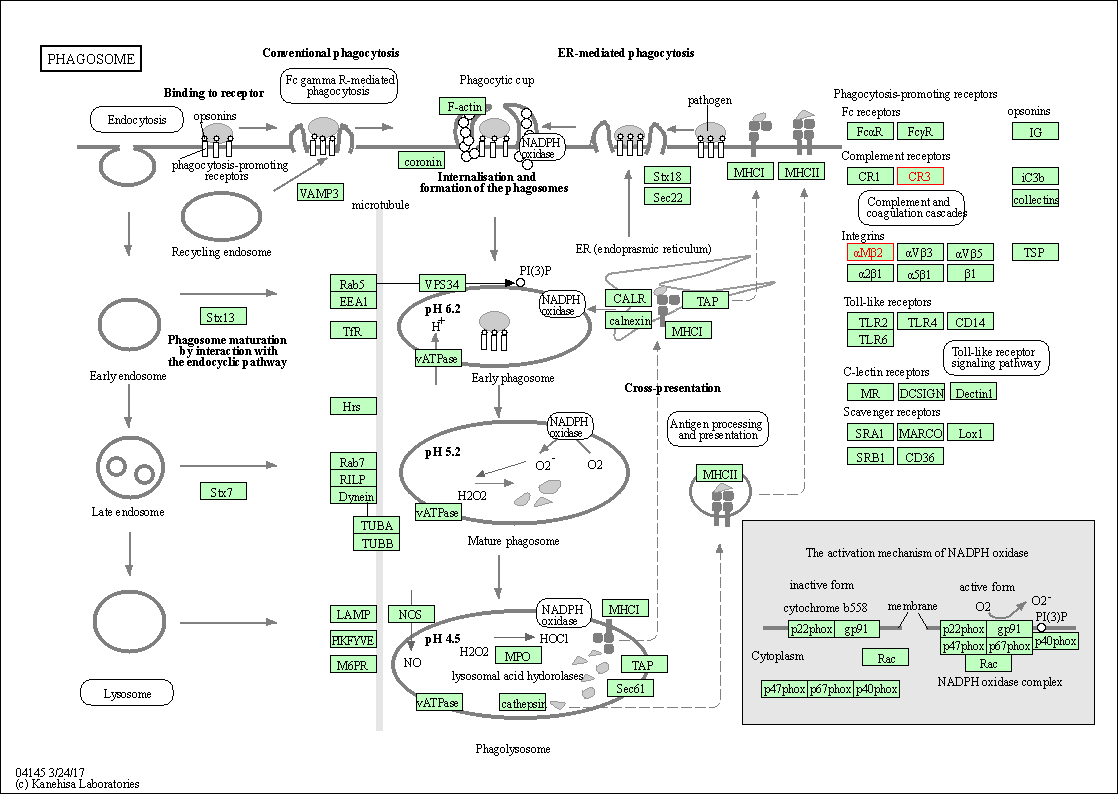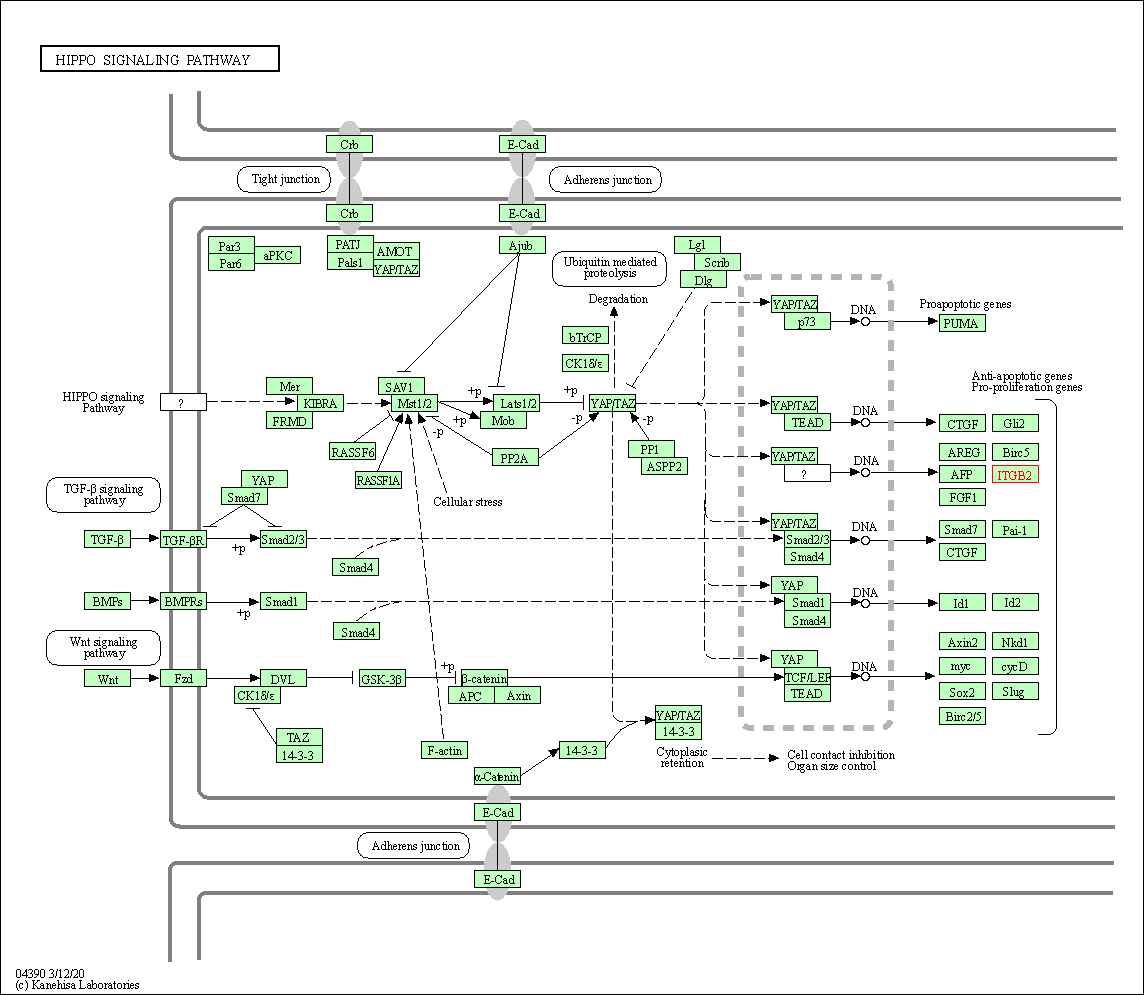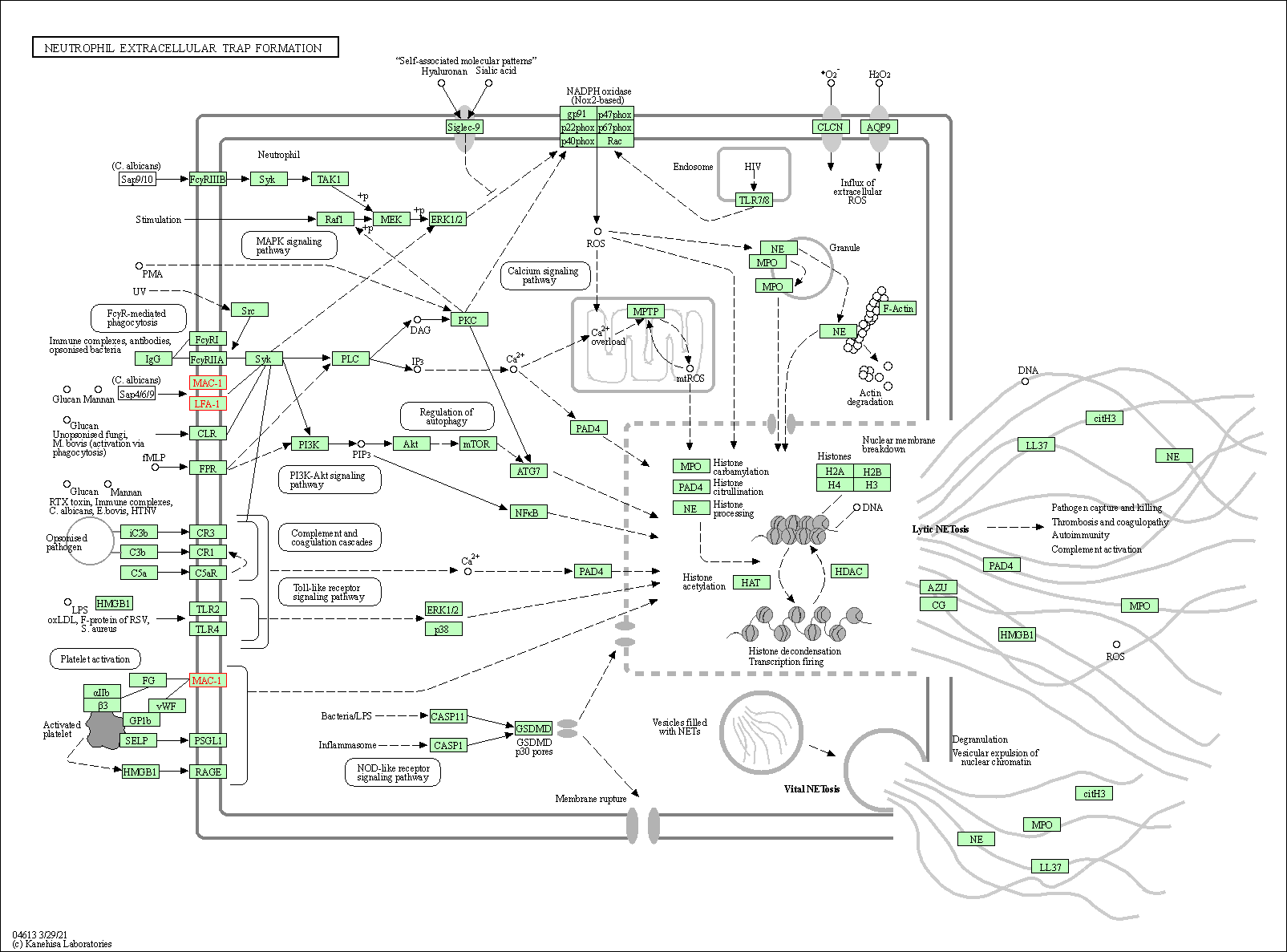Target Information
| Target General Information | Top | |||||
|---|---|---|---|---|---|---|
| Target ID |
T10513
(Former ID: TTDR01170)
|
|||||
| Target Name |
Integrin beta-2 (ITGB2)
|
|||||
| Synonyms |
MFI7; Integrin alpha-M/beta-2; Complement receptor C3 subunit beta; Cell surface adhesion glycoproteins LFA-1/CR3/p150,95 subunit beta; CD18
Click to Show/Hide
|
|||||
| Gene Name |
ITGB2
|
|||||
| Target Type |
Clinical trial target
|
[1] | ||||
| Disease | [+] 1 Target-related Diseases | + | ||||
| 1 | Innate/adaptive immunodeficiency [ICD-11: 4A00] | |||||
| Function |
Integrin ITGAL/ITGB2 is also a receptor for the secreted form of ubiquitin-like protein ISG15; the interaction is mediated by ITGAL. Integrins ITGAM/ITGB2 and ITGAX/ITGB2 are receptors for the iC3b fragment of the third complement component and for fibrinogen. Integrin ITGAX/ITGB2 recognizes the sequence G-P-R in fibrinogen alpha-chain. Integrin ITGAM/ITGB2 recognizes P1 and P2 peptides of fibrinogen gamma chain. Integrin ITGAM/ITGB2 is also a receptor for factor X. Integrin ITGAD/ITGB2 is a receptor for ICAM3 and VCAM1. Contributes to natural killer cell cytotoxicity. Involved in leukocyte adhesion and transmigration of leukocytes including T-cells and neutrophils. Triggers neutrophil transmigration during lung injury through PTK2B/PYK2-mediated activation. Integrin ITGAL/ITGB2 in association with ICAM3, contributes to apoptotic neutrophil phagocytosis by macrophages. In association with alpha subunit ITGAM/CD11b, required for CD177-PRTN3-mediated activation of TNF primed neutrophils. Integrin ITGAL/ITGB2 is a receptor for ICAM1, ICAM2, ICAM3 and ICAM4.
Click to Show/Hide
|
|||||
| BioChemical Class |
Integrin
|
|||||
| UniProt ID | ||||||
| Sequence |
MLGLRPPLLALVGLLSLGCVLSQECTKFKVSSCRECIESGPGCTWCQKLNFTGPGDPDSI
RCDTRPQLLMRGCAADDIMDPTSLAETQEDHNGGQKQLSPQKVTLYLRPGQAAAFNVTFR RAKGYPIDLYYLMDLSYSMLDDLRNVKKLGGDLLRALNEITESGRIGFGSFVDKTVLPFV NTHPDKLRNPCPNKEKECQPPFAFRHVLKLTNNSNQFQTEVGKQLISGNLDAPEGGLDAM MQVAACPEEIGWRNVTRLLVFATDDGFHFAGDGKLGAILTPNDGRCHLEDNLYKRSNEFD YPSVGQLAHKLAENNIQPIFAVTSRMVKTYEKLTEIIPKSAVGELSEDSSNVVQLIKNAY NKLSSRVFLDHNALPDTLKVTYDSFCSNGVTHRNQPRGDCDGVQINVPITFQVKVTATEC IQEQSFVIRALGFTDIVTVQVLPQCECRCRDQSRDRSLCHGKGFLECGICRCDTGYIGKN CECQTQGRSSQELEGSCRKDNNSIICSGLGDCVCGQCLCHTSDVPGKLIYGQYCECDTIN CERYNGQVCGGPGRGLCFCGKCRCHPGFEGSACQCERTTEGCLNPRRVECSGRGRCRCNV CECHSGYQLPLCQECPGCPSPCGKYISCAECLKFEKGPFGKNCSAACPGLQLSNNPVKGR TCKERDSEGCWVAYTLEQQDGMDRYLIYVDESRECVAGPNIAAIVGGTVAGIVLIGILLL VIWKALIHLSDLREYRRFEKEKLKSQWNNDNPLFKSATTTVMNPKFAES Click to Show/Hide
|
|||||
| 3D Structure | Click to Show 3D Structure of This Target | PDB | ||||
| HIT2.0 ID | T25VH1 | |||||
| Drugs and Modes of Action | Top | |||||
|---|---|---|---|---|---|---|
| Discontinued Drug(s) | [+] 3 Discontinued Drugs | + | ||||
| 1 | BMS-587101 | Drug Info | Discontinued in Phase 2 | Psoriasis vulgaris | [3] | |
| 2 | UK-279,276 | Drug Info | Discontinued in Phase 2 | Stroke | [4] | |
| 3 | MLN-2201 | Drug Info | Discontinued in Phase 1 | Cerebrovascular ischaemia | [5] | |
| Mode of Action | [+] 2 Modes of Action | + | ||||
| Inhibitor | [+] 2 Inhibitor drugs | + | ||||
| 1 | BMS-587101 | Drug Info | [6] | |||
| 2 | A-286982 | Drug Info | [8] | |||
| Antagonist | [+] 1 Antagonist drugs | + | ||||
| 1 | UK-279,276 | Drug Info | [1] | |||
| Cell-based Target Expression Variations | Top | |||||
|---|---|---|---|---|---|---|
| Cell-based Target Expression Variations | ||||||
| Drug Binding Sites of Target | Top | |||||
|---|---|---|---|---|---|---|
| Ligand Name: 2-(Acetylamino)-2-Deoxy-a-D-Glucopyranose | Ligand Info | |||||
| Structure Description | The crystal structure of the PSI/Hybrid domain/ I-EGF1 segment from the human integrin beta2 at 1.8 resolution | PDB:1YUK | ||||
| Method | X-ray diffraction | Resolution | 1.80 Å | Mutation | No | [9] |
| PDB Sequence |
> Chain A
QECTKFKVSS 10 CRECIESGPG20 CTWCQKLNFT30 GPGDPDSIRC40 DTRPQLLMRG50 CAADDIMDPT 60 SLAETQEQKQ75 LSPQKVTLYL85 RPGQAAAFNV95 TFRR> Chain B SRVFLDHNAL 352 PDTLKVTYDS362 FCSNGVTHRN372 QPRGDCDGVQ382 INVPITFQVK392 VTATECIQEQ 402 SFVIRALGFT412 DIVTVQVLPQ422 CECRCRDQSR432 DRSLCHGKGF442 LECGICRCDT 452 GYIGKNCEHH462
|
|||||
|
|
||||||
| Click to View More Binding Site Information of This Target with Different Ligands | ||||||
| Different Human System Profiles of Target | Top |
|---|---|
|
Human Similarity Proteins
of target is determined by comparing the sequence similarity of all human proteins with the target based on BLAST. The similarity proteins for a target are defined as the proteins with E-value < 0.005 and outside the protein families of the target.
A target that has fewer human similarity proteins outside its family is commonly regarded to possess a greater capacity to avoid undesired interactions and thus increase the possibility of finding successful drugs
(Brief Bioinform, 21: 649-662, 2020).
Human Tissue Distribution
of target is determined from a proteomics study that quantified more than 12,000 genes across 32 normal human tissues. Tissue Specificity (TS) score was used to define the enrichment of target across tissues.
The distribution of targets among different tissues or organs need to be taken into consideration when assessing the target druggability, as it is generally accepted that the wider the target distribution, the greater the concern over potential adverse effects
(Nat Rev Drug Discov, 20: 64-81, 2021).
Human Pathway Affiliation
of target is determined by the life-essential pathways provided on KEGG database. The target-affiliated pathways were defined based on the following two criteria (a) the pathways of the studied target should be life-essential for both healthy individuals and patients, and (b) the studied target should occupy an upstream position in the pathways and therefore had the ability to regulate biological function.
Targets involved in a fewer pathways have greater likelihood to be successfully developed, while those associated with more human pathways increase the chance of undesirable interferences with other human processes
(Pharmacol Rev, 58: 259-279, 2006).
Biological Network Descriptors
of target is determined based on a human protein-protein interactions (PPI) network consisting of 9,309 proteins and 52,713 PPIs, which were with a high confidence score of ≥ 0.95 collected from STRING database.
The network properties of targets based on protein-protein interactions (PPIs) have been widely adopted for the assessment of target’s druggability. Proteins with high node degree tend to have a high impact on network function through multiple interactions, while proteins with high betweenness centrality are regarded to be central for communication in interaction networks and regulate the flow of signaling information
(Front Pharmacol, 9, 1245, 2018;
Curr Opin Struct Biol. 44:134-142, 2017).
Human Similarity Proteins
Human Tissue Distribution
Human Pathway Affiliation
Biological Network Descriptors
|
|
|
Note:
If a protein has TS (tissue specficity) scores at least in one tissue >= 2.5, this protein is called tissue-enriched (including tissue-enriched-but-not-specific and tissue-specific). In the plots, the vertical lines are at thresholds 2.5 and 4.
|
| KEGG Pathway | Pathway ID | Affiliated Target | Pathway Map |
|---|---|---|---|
| Rap1 signaling pathway | hsa04015 | Affiliated Target |

|
| Class: Environmental Information Processing => Signal transduction | Pathway Hierarchy | ||
| Phagosome | hsa04145 | Affiliated Target |

|
| Class: Cellular Processes => Transport and catabolism | Pathway Hierarchy | ||
| Hippo signaling pathway | hsa04390 | Affiliated Target |

|
| Class: Environmental Information Processing => Signal transduction | Pathway Hierarchy | ||
| Cell adhesion molecules | hsa04514 | Affiliated Target |

|
| Class: Environmental Information Processing => Signaling molecules and interaction | Pathway Hierarchy | ||
| Complement and coagulation cascades | hsa04610 | Affiliated Target |

|
| Class: Organismal Systems => Immune system | Pathway Hierarchy | ||
| Neutrophil extracellular trap formation | hsa04613 | Affiliated Target |

|
| Class: Organismal Systems => Immune system | Pathway Hierarchy | ||
| Natural killer cell mediated cytotoxicity | hsa04650 | Affiliated Target |

|
| Class: Organismal Systems => Immune system | Pathway Hierarchy | ||
| Leukocyte transendothelial migration | hsa04670 | Affiliated Target |

|
| Class: Organismal Systems => Immune system | Pathway Hierarchy | ||
| Regulation of actin cytoskeleton | hsa04810 | Affiliated Target |

|
| Class: Cellular Processes => Cell motility | Pathway Hierarchy | ||
| Click to Show/Hide the Information of Affiliated Human Pathways | |||
| Degree | 29 | Degree centrality | 3.12E-03 | Betweenness centrality | 6.48E-04 |
|---|---|---|---|---|---|
| Closeness centrality | 2.11E-01 | Radiality | 1.37E+01 | Clustering coefficient | 8.37E-02 |
| Neighborhood connectivity | 1.38E+01 | Topological coefficient | 6.61E-02 | Eccentricity | 12 |
| Download | Click to Download the Full PPI Network of This Target | ||||
| Target Regulators | Top | |||||
|---|---|---|---|---|---|---|
| Target-regulating Transcription Factors | ||||||
| Target-interacting Proteins | ||||||
| Target-Related Models and Studies | Top | |||||
|---|---|---|---|---|---|---|
| Target Validation | ||||||
| References | Top | |||||
|---|---|---|---|---|---|---|
| REF 1 | Advances in ischemic stroke treatment: neuroprotective and combination therapies. Expert Opin Emerg Drugs. 2007 Mar;12(1):97-112. | |||||
| REF 2 | ClinicalTrials.gov (NCT03812263) A Clinical Trial to Evaluate the Safety and Efficacy of RP-L201 in Subjects With Leukocyte Adhesion Deficiency-I. U.S. National Institutes of Health. | |||||
| REF 3 | Small molecules, big targets: drug discovery faces the protein-protein interaction challenge.Nat Rev Drug Discov. 2016 Aug;15(8):533-50. | |||||
| REF 4 | Trusted, scientifically sound profiles of drug programs, clinical trials, safety reports, and company deals, written by scientists. Springer. 2015. Adis Insight (drug id 800003726) | |||||
| REF 5 | Trusted, scientifically sound profiles of drug programs, clinical trials, safety reports, and company deals, written by scientists. Springer. 2015. Adis Insight (drug id 800010178) | |||||
| REF 6 | Discovery and development of 5-[(5S,9R)-9-(4-cyanophenyl)-3-(3,5-dichlorophenyl)-1-methyl-2,4-dioxo-1,3,7-triazaspiro[4.4]non-7-yl-methyl]-3-thioph... J Med Chem. 2006 Nov 30;49(24):6946-9. | |||||
| REF 7 | Trusted, scientifically sound profiles of drug programs, clinical trials, safety reports, and company deals, written by scientists. Springer. 2015. Adis Insight (drug id 800010178) | |||||
| REF 8 | Novel p-arylthio cinnamides as antagonists of leukocyte function-associated antigen-1/intracellular adhesion molecule-1 interaction. 2. Mechanism o... J Med Chem. 2001 Apr 12;44(8):1202-10. | |||||
| REF 9 | The crystal structure of the plexin-semaphorin-integrin domain/hybrid domain/I-EGF1 segment from the human integrin beta2 subunit at 1.8-A resolution. J Biol Chem. 2005 Aug 26;280(34):30586-93. | |||||
If You Find Any Error in Data or Bug in Web Service, Please Kindly Report It to Dr. Zhou and Dr. Zhang.

